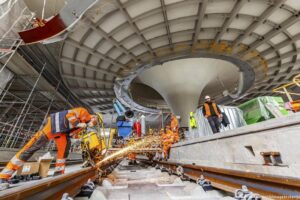
Australian property prices are predicted to smash records in every capital city by the end of 2026, driven by boosted government schemes and rising household incomes.
According to new forecasts released by property portal Domain on Thursday, Sydney is set to lead the national surge, with median house prices tipped to jump 7 per cent to $1.92million next year.
That figure edges dangerously close to the $2million mark — a level many first-home buyers say is now completely out of reach.
Melbourne is tipped to rebound sharply too, with prices expected to climb $87,000 to $1.17million, while Canberra is forecast to return to record highs.
Growth is expected to moderate in Brisbane, Adelaide and Perth, which have already seen rapid double-digit gains, but still rise by 4 to 5 per cent.
Domain’s chief of research Dr Nicola Powell said the expansion of the First Home Guarantee Scheme, which allows first-home buyers to purchase with a smaller deposit, would supercharge demand, pushing prices up as much as 6.6 per cent in the first year alone, and even higher if investors pile in.
‘Australia’s housing market is set for another strong year, with demand still strong and buyers continuing to chase affordability, particularly in the unit market, which is expected to outperform in several cities,’ she said.
‘There are encouraging signs on the horizon, with new housing supply starting to come to market as building activity picks up.
Record home prices are forecast across all capital cities by the end 2026 of as first home buyer activity surges under the expanded government scheme
Domain’s chief of research and economics Dr Nicola Powell (pictured) warned after a brief pause, rents are expected to accelerate again, rising 3 per cent across the combined capitals
First homebuyers and investors will be in competition with each to buy property across Australia next year say experts
‘While prices and rents will remain elevated, slower population growth, rising incomes and a cautious RBA should help the market move toward more balanced conditions by the end of 2026.’
Dr Powell said price growth was expected to slow in the second half of 2026 as affordability ceilings were reached, especially in Adelaide, Brisbane and Perth, which have already seen rapid double-digit increases that have pushed buyers to their limits.
‘House price growth in 2026 is forecast to be strongest in Sydney and Melbourne, consistent with their faster response to interest rate changes,’ she said.
‘Brisbane and Perth are expected to lead unit price growth, albeit at a slower pace than in previous years, as affordability becomes tighter.’
As prices surge in the cities, buyers in the regions have been feeling the spillover effects.
Regional dwelling values rose 2.4 per cent in the three months to October 31, the highest growth rate in more than three years, property analytics firm Cotality found.
While the spike in regional property prices at the height of the COVID-19 pandemic was driven by pull factors such as remote work and a desire for more space, the current growth phase is down to prospective buyers being priced out of the cities.
This month the RBA confirmed a hold on the cash rate, sparking fresh speculation about whether Australia has reached the end of the rate cutting cycle, or if further relief could still be on the cards in 2026.
AMP economist Shane Oliver (pictured) is predicting one rate cut next year by the Reserve Bank
InvestorKit head of research Arjun Paliwal (pictured) says people should take RBA comments on rate cuts with a grain of salt
But in bad news for mortgage holders, updated forecasts from the RBA show inflation is now not anticipated to be within the target band until the second half of 2026.
AMP economist Shane Oliver said most of the recent data released supported a ‘rates on hold’ scenario for now.
He said while RBA Deputy Governor Hauser didn’t rule out further rate cuts if the September quarter inflation spike proves to be temporary and the jobs market turns out to be weaker than the RBA thinks, the RBA’s hurdle to further cuts is clearly now high.
‘With jobs growth up and unemployment down in October, a strong rise in consumer confidence, solid business conditions and confidence readings and very strong growth in housing finance in the September quarter reinforcing that RBA rate cuts have got traction,’ he said.
‘However, while the RBA’s hurdle for another rate cut is high we remain of the view that the RBA will need to cut again next year.’
However InvestorKit head of research Arjun Paliwal said the the narrative that ‘cuts are done’ should be taken with caution.
‘The RBA has been wrong before, including in 2022 when it said rates wouldn’t rise, then raised them 13 times consecutively,’ he said.
‘The RBA is forecasting more cost-of-living pain and signalling the risk of no further cuts.
‘However, this is not necessarily how things will play out. The RBA still has to balance unemployment and the strength of the economy, and just because cuts have slowed for now, doesn’t mean this is the end.’
According to its latest whitepaper, there are 10 locations most primed to benefit if rates continue falling into 2026.
Mr Paliwal said Geelong, Hobart, Newcastle and Warrnambool were amongst the best markets for growth if rates were cut next year.
‘If the RBA delivers even one or two more cuts in 2026, these are the markets likely to join the growth conversations,’ he said.
In October, home prices grew by 1.1 per cent nationally – the fastest monthly growth rate since June 2023 – according to property analytics firm Cotality’s latest home value index.





